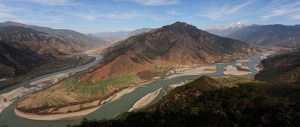Encyclopaedia of China Publishing House, January 2012
The Last Drift records a true-life journey in which a team of 29 people travelled down the Jinsha River. It may be the last such voyage, as dams are destroying this stretch of river, China’s most beautiful, forever.
Many of the expedition members already have strong links with the river. In the latter half of 2004 environmentalists Ma Jun, Lu Zhi, Deng Yisheng and Sun Shan joined with Ge Quanxiao, a villager from Wuzhu in Shangri-La, to call for Tiger Leaping Gorge, where the Yangtze makes its first bend, to be saved from dams. Author Liu Jianqiang – then a Southern Weekend reporter, now the Beijing editor of chinadialogue – and his colleagues brought the matter to public attention. After reading the article, then-premier Wen Jiabao ordered an investigation into illegal dam building.
But only five years later, work on a 545 km cascade of eight dams along Tiger Leaping Gorge started again. Once the dams are built, Liu writes, the flood will extend 200 km to the Tibetan prefecture of Diqing, drowning 200,000 mu of farmland and demanding the relocation of 100,000 people.
Debate over the pros and cons of dams remains furious, and developed nations are starting to reconsider their value. With Tiger Leaping Gorge soon to be lost, the Shan Shui Conservation Centre put together this expedition with Travis Winn, the American river guide who helped found Last Descents, a company dedicated to bringing people to the rivers of Western China. The aim was to allow more people to experience the majesty of the area firsthand, to turn observers into participants and rebuild their connections with nature.
The team sing as they float down peaceful rivers; they count the stars as they lie on the banks; and celebrate one member’s birthday. In the cliffs they see the marks said to be left by fish kissing the rocks, and they swap tales of nature. They raft over hair-raising rapids. People fall in, boats are overturned, and the reader is drawn into the emotions of the days. Two members, Zeng Qiang and Mou Zhengpeng, were married in a ceremony in the river, with the others applauding from their boats. But there was also sadness when they remembered it would not be long before that romantic spot would be inundated – they would never be able to visit this place again.
There was an interesting exchange between the team and workers on a small hydropower plant: How to balance the economy and the environment? The group and the individual? Everyone had their own opinions and their own way of talking – and so stalemate was inevitable. The team members examined their prior and current opinions and how they balanced the emotional and the rational, almost debating with their own selves. The Jinsha was no longer a distant name, it had actually touched the members, and they now felt affected by its fate.
They started to realise the significance of the river, and to understand why even those from other countries were upset that it might be dammed. They started to understand why their guide Dachuan so urgently wanted to “bring more Chinese people to see their mother river.” This may be the last river run – once it is gone, it cannot be recovered. We have left nature and work against it; we rationally analyse data and balance measurable economic gains with unpredictable environmental risks – but can this really be done?
That trip was three years ago now, and work is under way on seven of the dams in that eight-dam cascade. The reader, and even the participants, may ask what the trip really accomplished. It didn’t protect the river – wasn’t it just a bunch of rich people attempting to “find themselves”?
The Last Drift is an emotional book. Can protection of the environment founded on emotion be sustainable?
Wang Shi said that “one of the reasons making a difference in China is so difficult is that we are so cold.” This book attempts to use emotion to break through that coldness. If people felt linked to nature, if in every step we took nature into consideration, we would become more humble and polite, more thoughtful. Policy makers, policy implementers, stakeholders and observers, everywhere the seeds of environmental protection would be planted, and environmental protection would become a matter of action, not reaction, and we would no longer be isolated, becoming again one part of a natural chain. In this sense, the trip was a success.
The expedition did not save the river, but it changed the people on the trip. As Sun Shan wrote after the journey, “I hope more and more people will hear the voice of the river.” And as readers we can join up ourselves, rebuilding our links with nature, so that their trip will not be the last.
Long Ying is a chinadialogue translator and environmentalist.


